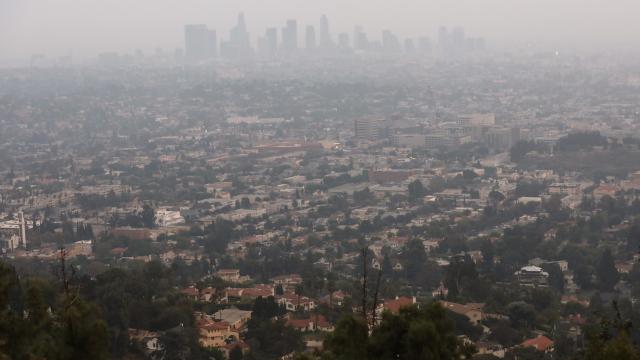The smoke from the fires out West, which has choked residents of California, Washington, and Oregon and painted the skies a haunting orange colour, is absolutely everywhere. It’s blown thousands of kilometres east, and is now clouding up skies as far away as parts of New England, parts of Canada, and even Europe. Yes, you read that right.
The hazy pollution is swirling around a section of high atmospheric pressure over the Great Basin, then getting caught in winds and flowing east of the Rocky Mountains. It’s moving eastward in two large gusts, one which has blown it across the upper western U.S. to the Great Lakes and over toward central New York, and the other that’s pulled it southwest through Missouri, Illinois and Kentucky, according to the National Oceanic and Atmospheric Administration.
Along parts of the East Coast, there’s enough smoke in the air to block some of the sun’s radiation. On Tuesday morning, the National Weather Service’s Baltimore-Washington, DC, office tweeted that smoke in the Northeast and Mid-Atlantic region was “obscuring the sun, and will keep temperatures a few degrees cooler today than what would be observed if the smoke was not present.” Officials from the NWS Wakefield, Virginia office also said wildfire smoke was bringing a “hazy, milky sky” to the region, and the New York state office said it was the culprit for the “yellow or brown tinge” in the air.
As if that’s not scary enough, late last week, Dutch climate scientist Geert Jan van Oldenborgh said that smoke had travelled as far as the Netherlands, making the “sky grey instead of blue.” That far away, the smoke isn’t affecting air quality on the ground. NBC news analysts said that since it’s suspended in the upper atmosphere, about 6,096.00 m up, there is no impact aside from end of days sunsets.
But over the West, where the wildfires have scorched over 1.8 million hectares with many still burning, the haze is creating a public health crisis. Across parts of California, Oregon, and Washington, officials have advised people to stay indoors to reduce their exposure to the smoke. Even parts of western Canada that haven’t been touched by the fires themselves are seeing sooty air.
The smoke isn’t just annoying, it’s also dangerous. It fills the air with particulate matter, tiny pollution particles that can make their way into people’s lungs and into their hearts when they’re inhaled, causing all sorts of health problems.
Last week, air quality readings were so bad that they were literally off the charts. The air quality index measures a variety of pollutants. Readings over 200 are considered “very unhealthy” for humans, and readings over 300 is are considered “hazardous” for anyone to spend any amount of time outside. The scale is meant to max out at 500, but parts of Oregon hit 599 on the EPA’s map, and surpassed 700 in other parts of the state on PurpleAir’s monitor.
The wildfires have killed at least 36 people so far and destroyed thousands of buildings. They were made so severe by record-breaking high temperatures and dry conditions, both hallmarks of climate change in the West. Because those weather conditions aren’t letting up, the fires are showing no signs of stopping. That means millions of people are going to have to continue choking on toxic air. Even after this fire season mercifully ends, many more people will suffer this fate unless the world takes serious steps to draw down greenhouse gas emissions. Otherwise, fires will just get worse in the future.
